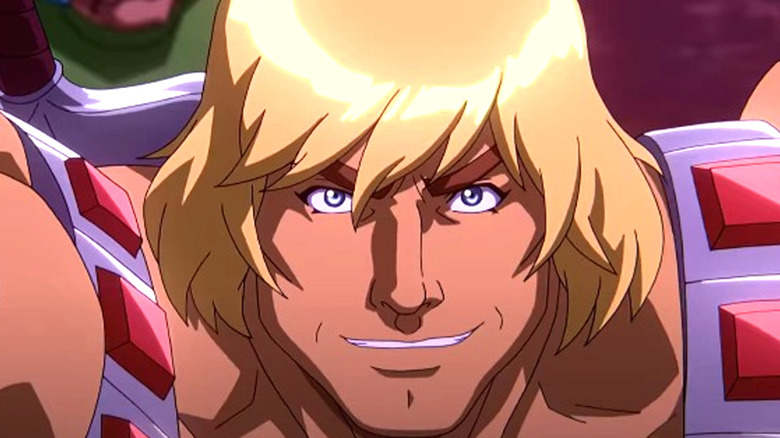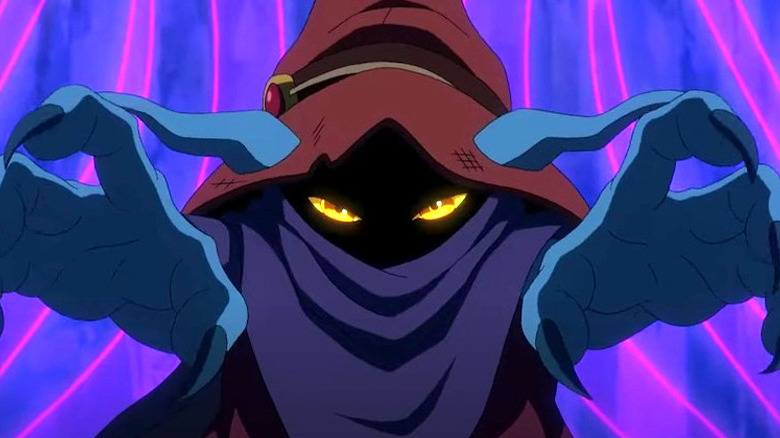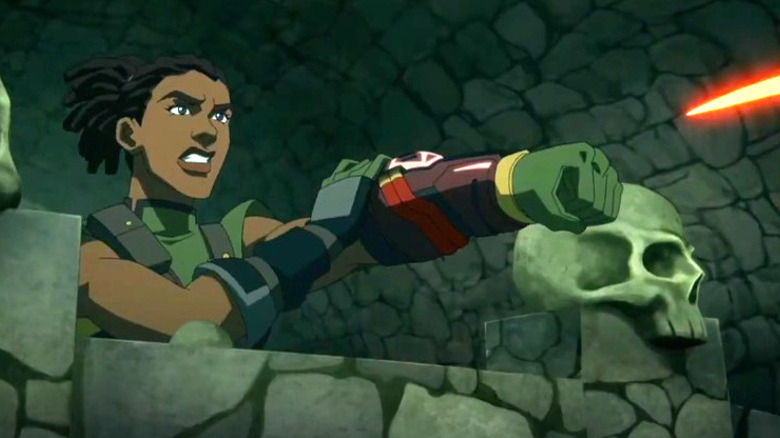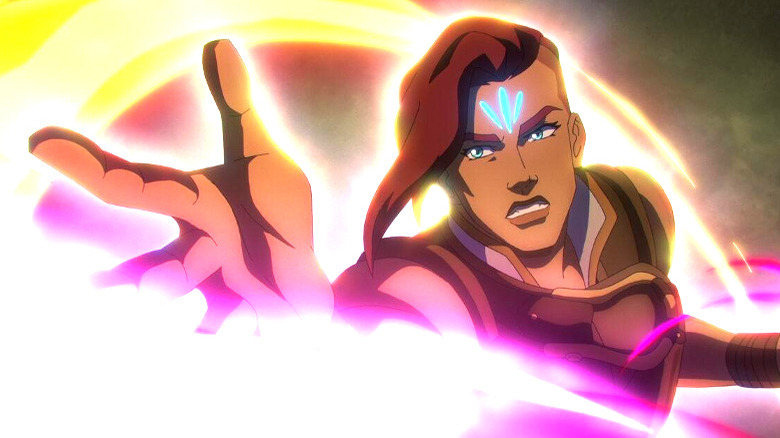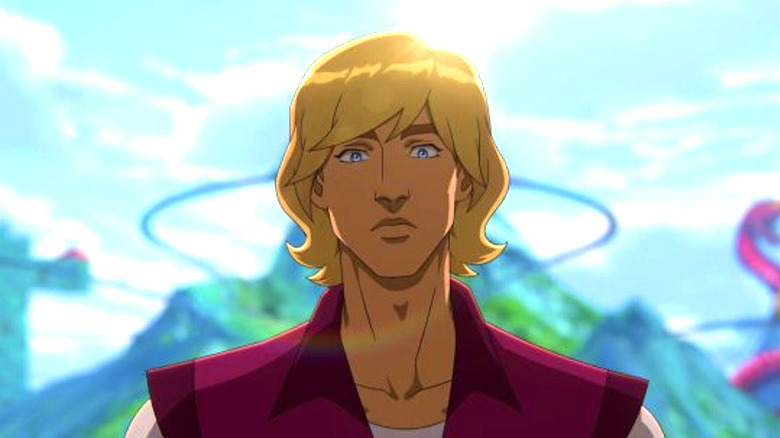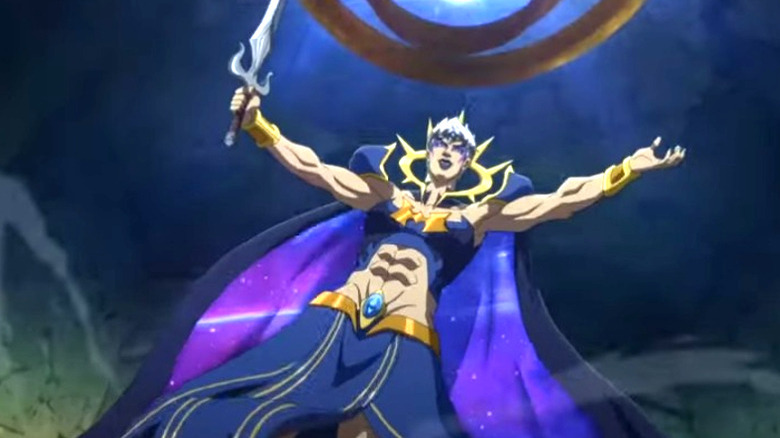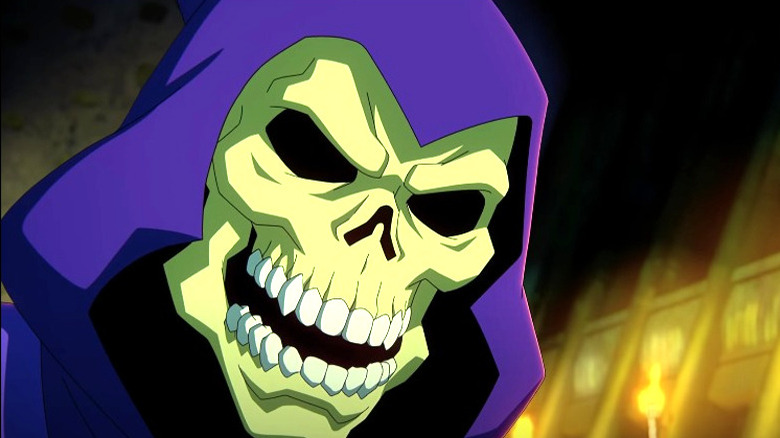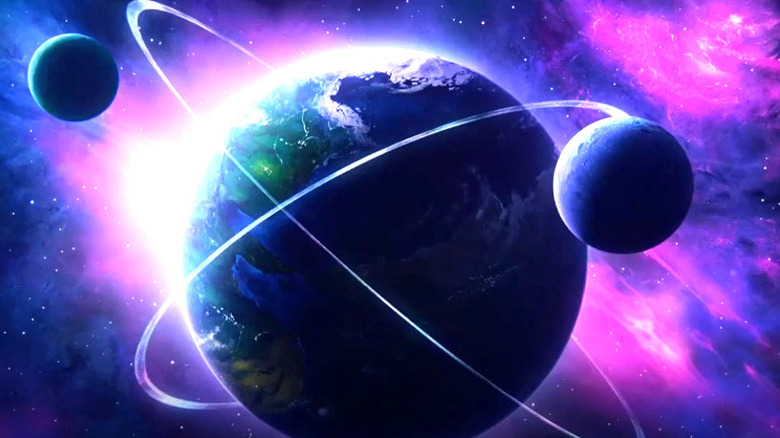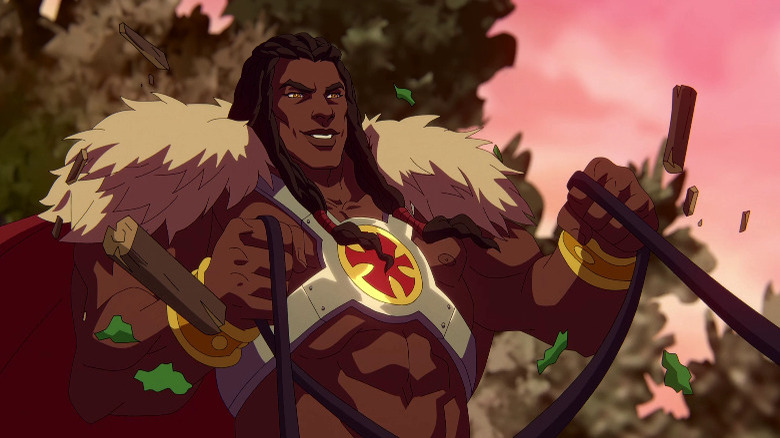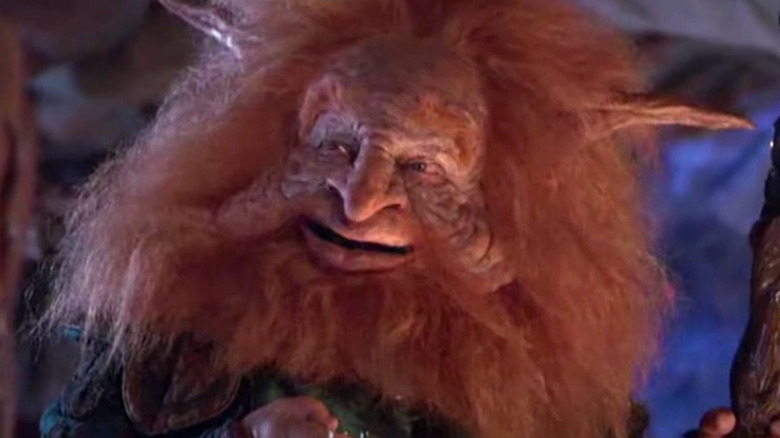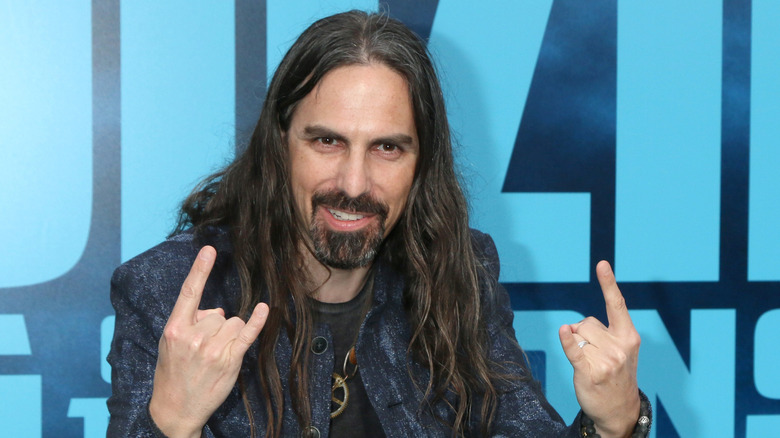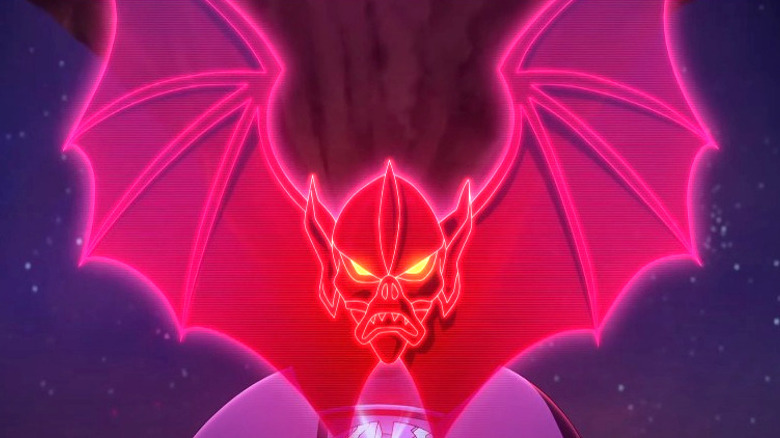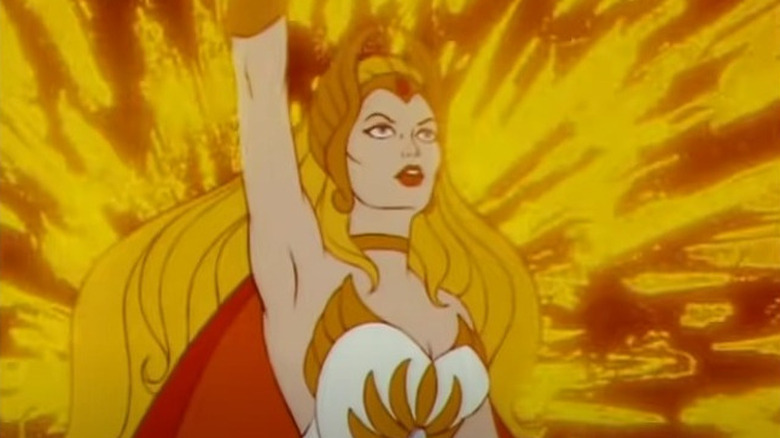What We Want To See From Masters Of The Universe: Revolution
"Masters of the Universe: Revelation" brought audiences back to the land of Eternia as depicted in the classic series "He-Man and the Masters of the Universe" — albeit with some pretty massive upgrades. It had been nearly 40 years since the original show was on the air, after all; huge technological strides have been made in animation, resulting in a crisper, sleeker aesthetic. Writing for animation has also gotten more sophisticated, leaving room for "Revelation" to add some much-needed depth to these beloved characters.
Executive produced by filmmaker Kevin Smith, the series tells a massive story that's as fresh as it is familiar. At first, the characters behave just as we remembered them. Then, however, through some devastating events, they're forced to grow and change. This quest of self-discovery culminates in a spectacular final battle; by the tale's conclusion, these old characters are suddenly new again, on the verge of forging new paths to the future.
With the sequel series "Masters of the Universe: Revolution" on the horizon, we decided to take a look at where the story left off and break down the characters and story elements we'd like to see further explored in the next volume.
Orko mastering his magical abilities
Orko is a love-or-hate kind of character. If you were the right age in the '80s, you probably loved him. He was small, adorable, and funny. Not only that, but he messed up. In a series full of incredible heroes, he would try things and fail. Seeing that trial and error process can be beneficial to a kid just trying to figure things out. If you were a little older back then, it's a safe bet that Orko wasn't your favorite. He ruined things, got in the way, and that voice was grating.
"Masters of the Universe: Revelation" rehabilitates Orko to a certain extent by making him self-aware. He knows he can be a nuisance, but his heart is so big and he wants to help so badly that he never gives up. Just when we have a new appreciation of him, he's killed in a heartbreaking moment.
Thankfully, Orko returns triumphant. With new robes and a greater grasp on his abilities, he becomes a force to be reckoned with, but he's still big-hearted, adorable Orko. "Revolution" would do a massive disservice to the character if he was simply amazing at everything now. Instead, it's important to show him learning how to use his magic and continue that trial and error process — just with more confidence this time.
More depth to Andra
After Prince Adam is killed and magic has left Eternia, Teela gives up her newly earned title of Man-At-Arms and goes out on her own. Retrieving missing objects for clients, she has help with her new career in the form of a friend named Andra. Although the character originally appeared in the comics, this is our first time seeing her onscreen. With all the drama going on, there isn't a lot of room to develop her beyond a simple character arc, but the series does set her up to be a major player in "Revolution."
We find out that Andra's never really had a family, and now she finally feels like she's part of something. She proves herself as a warrior on the battlefield and is rewarded by being promoted to Man-At-Arms while Teela is off being the Sorceress. Now that she's solidified as part of the "Masters of the Universe" crew, it makes sense to flesh her out a bit. She mentions her upbringing, but we don't know much beyond that. Perhaps a new villain or event will shake her confidence and she'll have to show us what she's really made of to defeat this new threat to the life she's always wanted.
Teela testing her potential
Early in "He-Man and the Masters of the Universe," the show aired an episode titled "Teela's Quest." Penned by "Batman: The Animated Series" writer Paul Dini, the episode is devoted to Teela and her search to discover who her mother is. She embarks on her dangerous journey to visit the Oracle of the Crystal Sea for answers, and we learn that her mother is the Sorceress. She appears and tells Teela that she will take her place one day, but erases her daughter's memory in order to protect her from those who might want her dead.
"Masters of the Universe: Revelation" delivers on this prophecy by making Teela re-learn the truth of her origin and embrace her destiny. It isn't something she walks into carelessly. Teela really struggles to accept the job, and getting her to the point where she does become the new Sorceress is what her entire journey this season has been leading up to.
Now that she's actively in the role, we have to see how she's coping. We saw that she would only accept the responsibility if she could do it her way and stay with her friends, and that decision is bound to have consequences. Before her, the Sorceress was always bound to Greyskull, but she can wander Eternia freely now. It will be very interesting to see what other changes she's able to make, and which ones might backfire.
Lots of Prince Adam
With characters who have secret identities, there's always the question of which persona is dominant. Does Superman see himself as Superman or Clark Kent? Is Batman the mask, or is it Bruce Wayne? They are both identities, but which one do they most strongly identify with? In the case of Prince Adam, "Masters of the Universe: Revelation" posits that the He-Man persona is a tool for peace and the real hero is Adam himself.
After being killed by Skeletor, Adam enters the afterlife for his final reward. He's served Eternia well and it's time for him to rest. He's just Adam here, because he sees his true identity as the son of King Randor and Queen Marlena, not He-Man. It's a poignant moment, reminding us that heroes aren't great because of their physical strength, it's their courage to do the right thing in the face of danger.
As great as it is to see He-Man taking fools out, it's wonderful to get a Prince Adam who is more than the corny guy who runs away to get changed when the bad guys show up. Adam the man is relatable and fascinating. He makes us believe that maybe we could one day wield the power as well, and it would be great to see more of him in "Revolution."
Evil-Lyn's new life
Skeletor's minion Evil-Lyn (voiced by Lena Headey) goes through quite the transformation by the end of "Masters of the Universe: Revelation." Like everyone else, she starts off in her usual role, but changes when the man she's been serving for years is murdered. She goes on to form an alliance with Adam's friends on their journey to the afterlife, only to end up betraying them when Skeletor returns. Imbued with the powers of the Sorceress, she seeks meaning. Realizing Skeletor is controlled by a petty grudge against He-Man, she claims the sword and calls down the power herself.
She manages to do more destruction and killing than Skeletor ever could during her brief time as Master of the Universe, until she realizes the error of her ways and gives up being evil while saving Orko from leaving his friends a second time. This woman has been through the wringer. Honestly, it's going to be difficult to make her sympathetic after she destroyed Heaven, but watching her potentially work to prove herself as one of the good guys will be gripping to watch. Can she continue to improve as a person, or will she resort to her old ways?
A more evil Skeletor
Despite his menacing image, the Skeletor seen in "He-Man and the Masters of the Universe" wasn't very scary. His plans were always thwarted, he didn't really kill anyone, and he sounded like a goof. All of that is great for that classic series — voice actor Alan Oppenheimer created a wonderful voice that truly sounded like it would come out of a skull, and his energy was always palpable. Besides, the show was obviously aimed at very young children; there's no need to create a truly terrifying villain for that audience.
The kids who watched that show are adults now, and able to handle more mature content. "Revelation" delivers on that with a Skeletor who is more prepared before carrying out a plan; one who actually murders those who stand in his way. Also, Mark Hamill's performance is a stunning tribute to Oppenheimer laced with malice.
With the final moments of "Masters of the Universe: Revelation" hinting at the possibility of Skeletor being reborn in a cybernetic form, there is potential to strip away the foolishness and make him cold, calculating, and deeply evil. Doing so would push the character into uncharted territory and present a real threat to He-Man and his friends.
New areas of Eternia
During the original series "He-Man and the Masters of the Universe," much of the planet of Eternia appeared barren. Every now and then, He-Man and friends would venture to some new location, but there wouldn't be a whole lot going on there; the whole planet appeared to exist in a gloomy atmosphere where anything could be lurking in the shadows. While it makes for some fantastic moody imagery, Eternia never felt like a place teeming with life. "Masters of the Universe: Revelation" changes that just enough to retain the classic look.
Eternos (the capital) has citizens walking around. The architecture is that incredible blend of remote and alien. When the characters venture into the Mystic Mountains, the flora and fauna are colorful and vibrant. It feels like a fully realized magical world akin to Narnia rather than just a spooky backdrop for battles. Exploring new lands on Eternia, meeting different cultures, and discovering hidden corners of the planet in "Revolution" would only make the setting more palpable — like this is a world that could exist even though it is populated by impossibilities.
More deep cuts and lore
There has always been a "let's try stuff out and see what works" vibe to "Masters of the Universe." Much of the time, the character designs don't make a lot of sense, the mythology is a little all over the place (in the original cartoon, at least), and the creators made so much content that there was barely time to develop all of their ideas. "Masters of the Universe: Revelation" started tying these loose threads together in a way that gave the world, its myths, and its characters a more cohesive shape.
We meet heroes from Eternia's past. We see Preternia and Subternia. There's a new dimension to Castle Greyskull. The larger universe is shown in a new way. Diving deeper into those elements in "Revolution" would further flesh out this fictional world. It would be nice to learn more about Adam's lineage and different legends Eternians share. The occasional mention here and there, or a storyline dealing with elements from Eternia's past, would go a long way toward giving everything more weight.
Shoutouts to the 1987 live-action film
For fans who were raised on "He-Man" reruns in the '80s and early '90s, the 1987 film starring Dolph Lundgren was just as important as the toys, the comics, and the show itself. Of course, compared to the series, this story about a cosmic key allowing people to travel between worlds (but spending most of their time on Earth) doesn't measure up. It's cool to see Eternia in live action and Dolph certainly looks like He-Man (plus, it's fun to see a pre-"Friends" Courteney Cox), but it was too cheap to live up to expectations.
This film is definitely the black sheep of the family, but it's still family, and "Revelation" underscored this by including a few shoutouts to the movie, including an appearance from the characters Blade and Pigboy. Bringing characters, technology, and moments in from the '87 film is a thrill for fans who still love it despite its numerous flaws. "Revolution" could easily toss in a few more references — or even bring in the character Gwildor.
While the little wizard (played by the superb Billy Barty) must have been created to serve as the film's answer to Orko, the show could bring him back as some ancient hermit wandering Eternia and tinkering with his cosmic key. Give Orko a wizard buddy. Why not?
Bear McCreary's epic score
Composer Bear McCreary has been providing incredible scores to franchises like "Battlestar Galactica," "The Angry Videogame Nerd," and "Godzilla" for years. Not content with trying to emulate classic film composers like John Williams or Jerry Goldsmith, McCreary is a mad professor of epic themes. There are layers to his work, wild experimentation that can only be fully appreciated upon multiple listens.
No one else could have adequately emphasized the scope and scale of the story being told in "Masters of the Universe: Revelation." As memorable as that original opening theme is, for all the wonderful nostalgia buttons it presses, Bear's metal-inspired triumphant theme for "Revelation" conjures an emotional response that makes you feel the same excitement you had as a kid, but on a much grander scale.
McCreary was clearly thrilled to write this score, and it shows. This is the kind of film/television music that you can put on and listen to over and over. It stands on its own while perfectly accentuating the story it was designed to accompany. If McCreary doesn't return for "Revolution," the person they end up hiring will have behemoth shoes to fill.
Bring in Hordak
The final moments of "Masters of the Universe: Revelation" offer a hint toward where "Revolution" might be heading. After his defeat, Skeletor retreats to Snake Mountain, where Tri-Klops has been leading an anti-magic cult that worships something called Motherboard. Furious over his defeat, Skeletor resolves to punish Tri-Klops and his followers for abandoning him. They blame Motherboard for making them do her bidding.
Skeletor attempts to destroy their idol, but it doesn't work. Instead, the statue transforms into a form resembling a mechanical woman with wings. She digs her nails into Skeletor and starts pumping him full of the liquid that transforms people into cyborgs. Then a hologram emerges from the top of her head. It is a red bat: the symbol of Horak.
Fans of "She-Ra: The Princess of Power" will remember Hordak as that show's primary villain. He has history with Skeletor, as He-Man's nemesis trapped him in an alternate dimension. Seeing this symbol could mean Hordak is returning (again), or that Hordak loyalists exist in Eternia. It's unclear what it all means, but it would be incredible to see Hordak team up with a cyborg Skeletor to rule Eternia once and for all.
The Princess of Power
If they're bringing in Hordak, then it only makes sense to reintroduce Adam's twin sister Adora, aka She-Ra. The series "She-Ra: The Princess of Power" saw the eponymous hero and the Great Rebellion battling Hordak and his Evil Horde every week. The title "Masters of the Universe: Revolution" certainly sounds like some kind of evil will try to take over Eternia, and our band of heroes will have to stand against it. If that evil is in fact Hordak, why not have She-Ra and He-Man fight side by side?
She has her own successful Netflix series, "She-Ra and the Princesses of Power," but that doesn't mean she can't show up in "Revolution" as well. Besides, it would likely be a different version of the character, since "Princesses of Power" exists in its own continuity. And anyway, it isn't like Netflix is worried about over-saturating the brand: In addition to "Revelation" and "Revolution," there's another "He-Man and the Masters of the Universe" series on the streaming service as well. There's plenty of room for more than one She-Ra.
